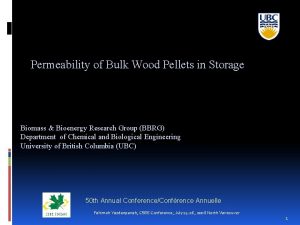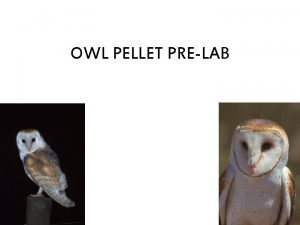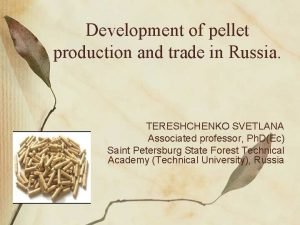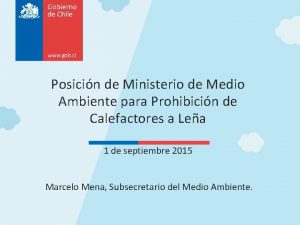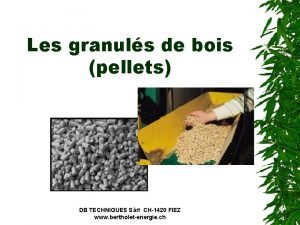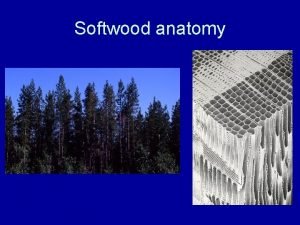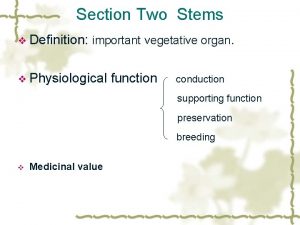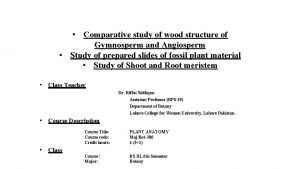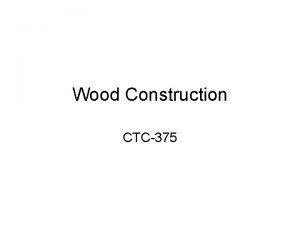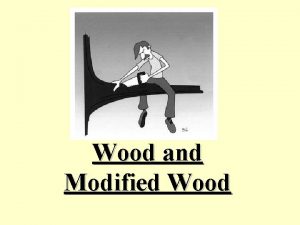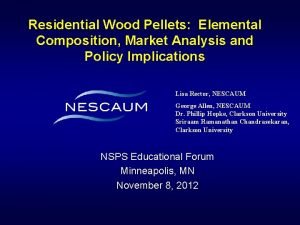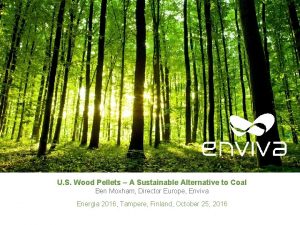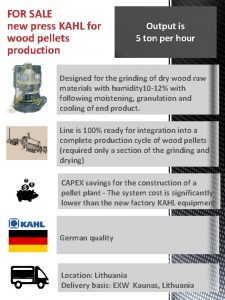Contents I What are Wood Pellets a Definition



















- Slides: 19

Contents I. What are Wood Pellets? a. Definition b. Global market II. Wood Bioenergy Policy a. Background b. Current Policy c. Future Plan III. Cooperate between ROK-RI 2

Ⅰ. What are Wood Pellets? q Compressed biomass Sawdust, wastes from sawmilling Normally 6 mm diameter High pressure of the press lignin plasticize forming a natural “glue” q Wood Torrefaction Hydrophobic property Ø Tending not to dissolve Store in open air, easy to dry reduce logistics cost Roasting temp 200 -300℃ 3

Global wood pellets market q Since 2006 a large growth q Global Market consumption : EU (11 million ton, 2010) production : EU (9 million ton, 2010) Ø traditional producing : Germany, Sweden, Austria (small capa : below 10, 000 tons/y) Ø New : US, Canada, Russia (Large capa : several hundred thousand tons/y) • launch World’s first biomass exchange (2011. Nov) • ISO : international standard quality of solid biofuels Source: Global wood pellets Market & Industry Ø Wood pellet, briquette etc (by 2014) 2011 // www. bioenergytrade. org 4

Increase Global wood pellet market q Industrial pellets for co-firing, CHP(combined heat & power plant), district heating Northern Europe : Netherlands, Belgium, UK Green electricity policy q Residential heating such as pellet stoves and boilers, especially rural areas Italy, Austria, Germany q Increase demand in EU stimulate large investments in new pellet plants Canada, U. S. , Russia 5

6

Background q Address Energy Crisis Depleting fossil fuel resources (unstable supply/ raising price) and reduce dependence on fuel imports q Respond to Climate change Reduce carbon emission : 2009, set target by 2020, BAU standard reduction 30% q Demand Alternative/ Renewable Energy Korea’s energy index world’s 10 th largest energy consumer, 5 th largest oil importer, 2 nd largest coal importer, 64% of electricity produced from fossil fuels 7

The 1 st National Basic Energy plan (2008 -2030) q Vision Improve national energy efficiency Expand low-carbon clean energy ratios Cultivate Green Energy Industry q Characteristics Support Low-Carbon, Green Growth paradigm Long term & Response to the post-oil era Consider Efficiency, environment, security in the energy q Target Share renewable energy to 11% by 2030 8

Key Policies since 2012 9

Master plan for wood pellet by 2020 (Korea Forest Service) Biomass energy : Carbon- neutral, Sustainable & local fuels q Goal : stimulate Forest biomass toward Green Growth q Action Enlarge base of wood pellet consumption Facilitate wood pellet industry Support standard/quality of wood pellet 10

1) Enlarge base of Wood Pellet Consumption Subsidize purchase of pellet boilers for rural areas by 60% Ø Ø Yearly Boilers : (2008) 650 (2009) 3, 000 (2011) 4, 000 No. Total boilers : app. 14, 000 (app. 52, 000 ton) Agricultural(greenhouse) wood pellet boilers Ø Ø (2010) 138 ha (2011) 140 ha App. 430 ha, 94, ooo ton consumption Industrial boilers : steam boiler Ø App. 1, 000 boilers, 40, 000 ton(2012) Power generation by RPS 11

Wood pellet Consumption (as of 2012) q consumption Rapid increase Ø (’ 09)18, 216 ton Ø (’ 12) 174, 068 ton 12

Import 13

Future prospect Consumption : (2013) 250, 000 ton (2017) 1, 100, 000 Source : Korea Forest Service (2013) 14

2) Facilitate wood pellet industry Support domestic wood pellet plants Ø (2008) 1 (2009) 9 (2012) 21 plants/ 120, 000 ton capacity Encourage invest overseas supply network Ø extend 11 firms abroad ( 490, 000 ton capacity) Establish wood Bio Energy Forests Ø Ø Saemangeum reclaimed land, dam watershed areas (5, 000 ha, 20122016) Plant short rotation species Source : Korea Forest Service 15

3) Support institutionalization q Standard / quality of wood pellet Regulated quality grades of wood pellet (2009) Enacted mandatory labeling of quality (2010) Enacted quality certification for residential wood pellet boiler (2012) Implemented wood pellet boiler cost accounting system (2012) Ø Target : ease burdens of consumer by cutting down costs 16

Ⅲ. Korea-Indonesia Cooperation q Long forest cooperative history since 1968 (2009) 200, 000 ha biomass plantation MOU q Current progress (2009) Solarpark : establish wood pellet factory (2010 -2013) ODA Project : wood biomass development model (2010 -2012) ODA Project : production bioenergy from Palm oil miss effluent Invest Korean Companies : plantation, produce wood pellet, residues/wastes from Palm oil * KGPA-Perum Perhutani, Semarang 17

Permata Hijau, Indonesia q Potentiality Abundant Forests, degraded forest land Make a pilot model Ø 20, 000 biomass one-stop project Research wood pellet by tropical species q Incentive Policy Draw attention to biomass, wood pellet/ plantation short rotation coppice Mandatory : RPS Target global wood pellet market Establish Master plan for national energy with renewables 18

Pellet industry challenges q enlarging the feedstock for wood pellets Sawdust, sawmill residues Alternative : forest industrial round wood, short rotation forestry plantations Move upstream of supply chain Ø Long term forest concession, long term supply agreement q Refining the quality of pellets : torrefaction q Improving logistics & transportation infrastructure q. Ensure sustainability : sustainable production, trade, use etc 19

Future : Sustainable biomass energy 20
 Insidan region jh
Insidan region jh Indeck ladysmith wi
Indeck ladysmith wi Bulk wood pellets saskatchewan
Bulk wood pellets saskatchewan Sotto pellets
Sotto pellets Kidwings owl pellet
Kidwings owl pellet Seven in russian
Seven in russian Centrifuge equation
Centrifuge equation Estufas a leña permitidas en santiago
Estufas a leña permitidas en santiago Db pellets
Db pellets Longitudinal tracheids
Longitudinal tracheids Aerial stem modification examples
Aerial stem modification examples Comparative wood anatomy
Comparative wood anatomy Esau wood poem
Esau wood poem Wood wood teenager
Wood wood teenager Work portfolio examples
Work portfolio examples Deep perineal pouch contents
Deep perineal pouch contents Trali symptoms
Trali symptoms Fresh frozen plasma vs platelets
Fresh frozen plasma vs platelets Endothoracic fascia
Endothoracic fascia Content of popliteal fossa
Content of popliteal fossa


